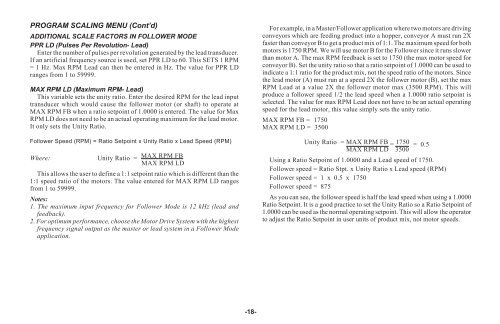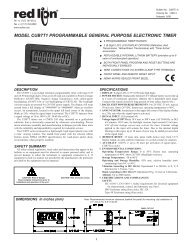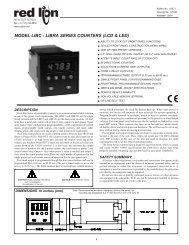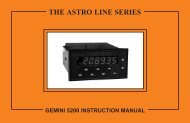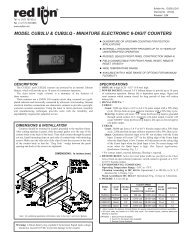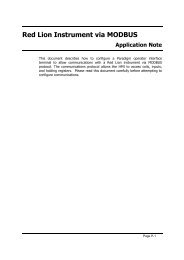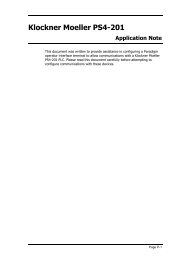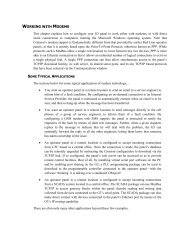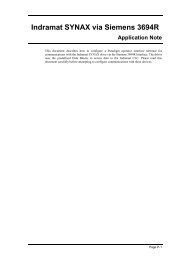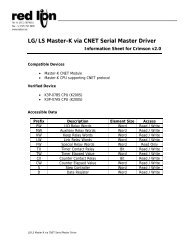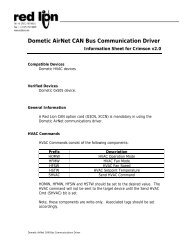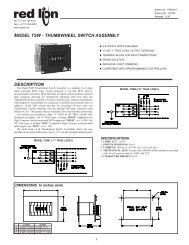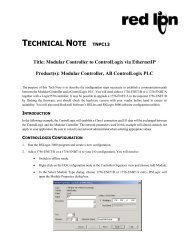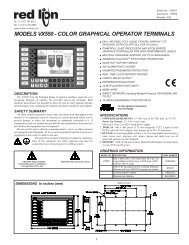MDC Manual 1109KB - Red Lion Controls
MDC Manual 1109KB - Red Lion Controls
MDC Manual 1109KB - Red Lion Controls
Create successful ePaper yourself
Turn your PDF publications into a flip-book with our unique Google optimized e-Paper software.
PROGRAM SCALING MENU (Cont’d)<br />
ADDITIONAL SCALE FACTORS IN FOLLOWER MODE<br />
PPR LD (Pulses Per Revolution- Lead)<br />
Enter the number of pulses per revolution generated by the lead transducer.<br />
If an artificial frequency source is used, set PPR LD to 60. This SETS 1 RPM<br />
= 1 Hz. Max RPM Lead can then be entered in Hz. The value for PPR LD<br />
ranges from 1 to 59999.<br />
MAX RPM LD (Maximum RPM- Lead)<br />
This variable sets the unity ratio. Enter the desired RPM for the lead input<br />
transducer which would cause the follower motor (or shaft) to operate at<br />
MAX RPM FB when a ratio setpoint of 1.0000 is entered. The value for Max<br />
RPM LD does not need to be an actual operating maximum for the lead motor.<br />
It only sets the Unity Ratio.<br />
Follower Speed (RPM) = Ratio Setpoint x Unity Ratio x Lead Speed (RPM)<br />
Where: Unity Ratio = MAX RPM FB<br />
MAX RPM LD<br />
This allows the user to define a 1:1 setpoint ratio which is different than the<br />
1:1 speed ratio of the motors. The value entered for MAX RPM LD ranges<br />
from 1 to 59999.<br />
Notes:<br />
1. The maximum input frequency for Follower Mode is 12 kHz (lead and<br />
feedback).<br />
2. For optimum performance, choose the Motor Drive System with the highest<br />
frequency signal output as the master or lead system in a Follower Mode<br />
application.<br />
-18-<br />
For example, in a Master/Follower application where two motors are driving<br />
conveyors which are feeding product into a hopper, conveyor A must run 2X<br />
faster than conveyor B to get a product mix of 1:1. The maximum speed for both<br />
motors is 1750 RPM. We will use motor B for the Follower since it runs slower<br />
than motor A. The max RPM feedback is set to 1750 (the max motor speed for<br />
conveyor B). Set the unity ratio so that a ratio setpoint of 1.0000 can be used to<br />
indicate a 1:1 ratio for the product mix, not the speed ratio of the motors. Since<br />
the lead motor (A) must run at a speed 2X the follower motor (B), set the max<br />
RPM Lead at a value 2X the follower motor max (3500 RPM). This will<br />
produce a follower speed 1/2 the lead speed when a 1.0000 ratio setpoint is<br />
selected. The value for max RPM Lead does not have to be an actual operating<br />
speed for the lead motor, this value simply sets the unity ratio.<br />
MAX RPM FB = 1750<br />
MAX RPM LD = 3500<br />
Unity Ratio = MAX RPM FB = 1750 = 0.5<br />
MAX RPM LD 3500<br />
Using a Ratio Setpoint of 1.0000 and a Lead speed of 1750.<br />
Follower speed = Ratio Stpt. x Unity Ratio x Lead speed (RPM)<br />
Follower speed = 1 x 0.5 x 1750<br />
Follower speed = 875<br />
As you can see, the follower speed is half the lead speed when using a 1.0000<br />
Ratio Setpoint. It is a good practice to set the Unity Ratio so a Ratio Setpoint of<br />
1.0000 can be used as the normal operating setpoint. This will allow the operator<br />
to adjust the Ratio Setpoint in user units of product mix, not motor speeds.


